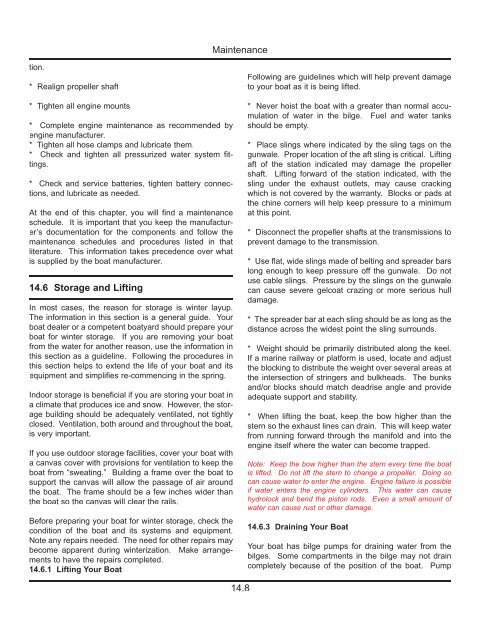36e Operator's Manual 2011.pdf - Marlow-Hunter, LLC
36e Operator's Manual 2011.pdf - Marlow-Hunter, LLC
36e Operator's Manual 2011.pdf - Marlow-Hunter, LLC
You also want an ePaper? Increase the reach of your titles
YUMPU automatically turns print PDFs into web optimized ePapers that Google loves.
Maintenance<br />
tion.<br />
* Realign propeller shaft<br />
* Tighten all engine mounts.<br />
* Complete engine maintenance as recommended by<br />
engine manufacturer.<br />
* Tighten all hose clamps and lubricate them.<br />
* Check and tighten all pressurized water system fittings.<br />
* Check and service batteries, tighten battery connections,<br />
and lubricate as needed.<br />
At the end of this chapter, you will find a maintenance<br />
schedule. It is important that you keep the manufacturer’s<br />
documentation for the components and follow the<br />
maintenance schedules and procedures listed in that<br />
literature. This information takes precedence over what<br />
is supplied by the boat manufacturer.<br />
14.6 Storage and Lifting<br />
In most cases, the reason for storage is winter layup.<br />
The information in this section is a general guide. Your<br />
boat dealer or a competent boatyard should prepare your<br />
boat for winter storage. If you are removing your boat<br />
from the water for another reason, use the information in<br />
this section as a guideline. Following the procedures in<br />
this section helps to extend the life of your boat and its<br />
equipment and simplifies re-commencing in the spring.<br />
Indoor storage is beneficial if you are storing your boat in<br />
a climate that produces ice and snow. However, the storage<br />
building should be adequately ventilated, not tightly<br />
closed. Ventilation, both around and throughout the boat,<br />
is very important.<br />
If you use outdoor storage facilities, cover your boat with<br />
a canvas cover with provisions for ventilation to keep the<br />
boat from “sweating.” Building a frame over the boat to<br />
support the canvas will allow the passage of air around<br />
the boat. The frame should be a few inches wider than<br />
the boat so the canvas will clear the rails.<br />
Before preparing your boat for winter storage, check the<br />
condition of the boat and its systems and equipment.<br />
Note any repairs needed. The need for other repairs may<br />
become apparent during winterization. Make arrangements<br />
to have the repairs completed.<br />
14.6.1 Lifting Your Boat<br />
Following are guidelines which will help prevent damage<br />
to your boat as it is being lifted.<br />
* Never hoist the boat with a greater than normal accumulation<br />
of water in the bilge. Fuel and water tanks<br />
should be empty.<br />
* Place slings where indicated by the sling tags on the<br />
gunwale. Proper location of the aft sling is critical. Lifting<br />
aft of the station indicated may damage the propeller<br />
shaft. Lifting forward of the station indicated, with the<br />
sling under the exhaust outlets, may cause cracking<br />
which is not covered by the warranty. Blocks or pads at<br />
the chine corners will help keep pressure to a minimum<br />
at this point.<br />
* Disconnect the propeller shafts at the transmissions to<br />
prevent damage to the transmission.<br />
* Use flat, wide slings made of belting and spreader bars<br />
long enough to keep pressure off the gunwale. Do not<br />
use cable slings. Pressure by the slings on the gunwale<br />
can cause severe gelcoat crazing or more serious hull<br />
damage.<br />
* The spreader bar at each sling should be as long as the<br />
distance across the widest point the sling surrounds.<br />
* Weight should be primarily distributed along the keel.<br />
If a marine railway or platform is used, locate and adjust<br />
the blocking to distribute the weight over several areas at<br />
the intersection of stringers and bulkheads. The bunks<br />
and/or blocks should match deadrise angle and provide<br />
adequate support and stability.<br />
* When lifting the boat, keep the bow higher than the<br />
stern so the exhaust lines can drain. This will keep water<br />
from running forward through the manifold and into the<br />
engine itself where the water can become trapped.<br />
Note: Keep the bow higher than the stern every time the boat<br />
is lifted. Do not lift the stern to change a propeller. Doing so<br />
can cause water to enter the engine. Engine failure is possible<br />
if water enters the engine cylinders. This water can cause<br />
hydrolock and bend the piston rods. Even a small amount of<br />
water can cause rust or other damage.<br />
14.6.3 Draining Your Boat<br />
Your boat has bilge pumps for draining water from the<br />
bilges. Some compartments in the bilge may not drain<br />
completely because of the position of the boat. Pump<br />
14.8

















